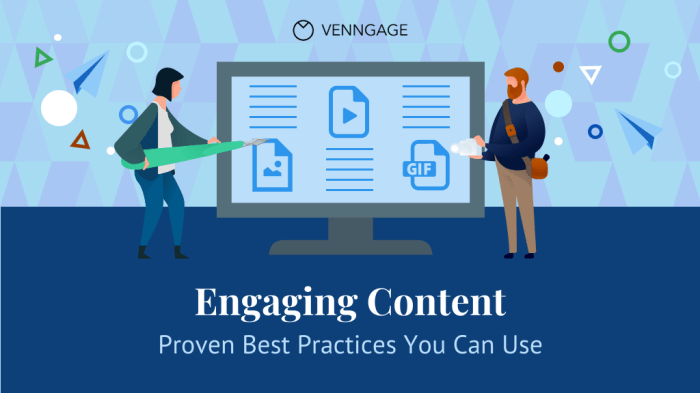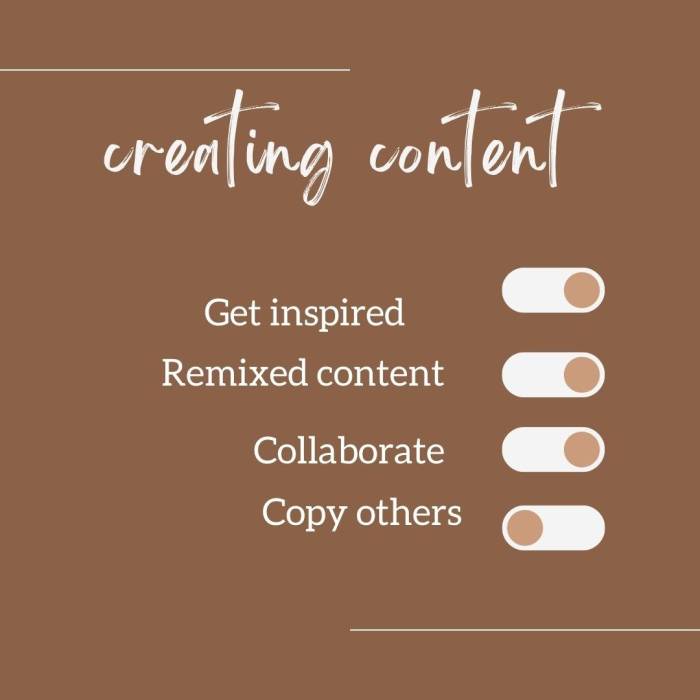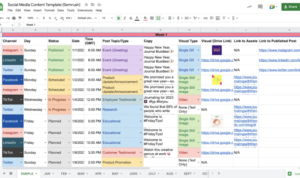Creating Engaging Blog Content is like the cool kid in high school, drawing readers in with a mix of knowledge and style, guaranteeing a fun and fresh read.
Let’s dive into the world of captivating content creation and explore the key elements that make blogs stand out.
Importance of Engaging Blog Content
Creating engaging blog content is essential for attracting and retaining readers in today’s digital landscape. With the vast amount of content available online, it is crucial to stand out and capture the attention of your audience. Engaging content not only keeps readers interested and coming back for more but also helps in building a loyal following.
Examples of Successful Blogs with Highly Engaging Content
- The Blonde Abroad: This travel blog combines stunning visuals with personal stories and practical tips, creating a compelling narrative that resonates with readers.
- Nerd Fitness: By blending fitness advice with pop culture references and a touch of humor, this blog makes health and wellness fun and relatable for a wide audience.
- BuzzFeed: Known for its listicles, quizzes, and entertaining content, BuzzFeed has mastered the art of engaging readers through interactive and shareable posts.
Impact of Engaging Content
Engaging content has a significant impact on user experience, brand visibility, and rankings. When users find content that captures their interest and provides value, they are more likely to spend time on the website, share the content with others, and return for future updates. This leads to increased brand awareness, credibility, and ultimately, higher search engine rankings due to increased traffic and engagement.
Understanding Your Audience

To create engaging blog content, it is crucial to understand your audience and tailor your posts to resonate with them. Audience research is key in this process, as it helps you gather insights into the preferences, demographics, and behavior of your target readers.
Audience Research Process
Audience research involves analyzing data from various sources such as social media, website analytics, and surveys to identify key characteristics of your audience. This includes their age, gender, location, interests, and online behavior. By understanding these details, you can create content that is relevant and valuable to your readers.
- Utilize social media analytics tools to track engagement metrics such as likes, shares, and comments to understand which type of content resonates with your audience.
- Use website analytics tools like Google Analytics to gather data on your audience’s demographics, behavior flow, and popular content to tailor your blog posts accordingly.
- Conduct surveys or polls to directly ask your audience about their preferences, interests, and feedback on your content to gain valuable insights.
Creating Buyer Personas
Creating buyer personas is essential in personalizing content for different audience segments. By developing fictional representations of your ideal customers based on real data, you can better understand their needs, motivations, and pain points to create targeted content that resonates with them.
- Segment your audience based on common characteristics such as age, job role, goals, challenges, and buying behavior to create distinct buyer personas.
- Craft content that addresses the specific needs and interests of each buyer persona, tailoring your tone, messaging, and storytelling to appeal to their unique preferences.
- Regularly update and refine your buyer personas based on new data and feedback to ensure your content remains relevant and engaging to your target audience.
Crafting Compelling Headlines
Crafting a compelling headline is crucial to catching the eye of your readers and enticing them to click on your blog post. Here are some tips to help you create catchy and click-worthy headlines:
Using Power Words, Creating Engaging Blog Content
Using power words in your headlines can evoke strong emotions and grab the attention of your audience. Words like “ultimate,” “essential,” “exclusive,” and “unveil” can add a sense of importance to your headline.
- Discover the Ultimate Guide to Blogging Success
- Unveil the Secrets of Effective Content Marketing
Incorporating Numbers
Including numbers in your headlines can make them more specific and appealing to readers. Whether it’s a listicle or a how-to guide, numbers can create a sense of structure and promise valuable information.
- 5 Proven Strategies to Boost Your Social Media Engagement
- 10 Tips for Creating Engaging Blog Content
Creating a Sense of Urgency
Adding a sense of urgency to your headlines can encourage readers to act quickly and not miss out on valuable information. Phrases like “limited time offer,” “don’t miss out,” and “act now” can create a sense of FOMO (fear of missing out).
- Don’t Miss Out on Our Exclusive Content Creation Workshop
- Act Now to Double Your Website Traffic in 30 Days
Writing Engaging Content
Storytelling plays a crucial role in creating engaging blog content as it helps captivate readers by adding a personal touch and emotional connection to the information being shared. By weaving narratives into your posts, you can make the content more relatable and memorable for your audience.
Techniques for Creating Engaging Content
Using anecdotes is a powerful way to draw readers in and make your content more engaging. Sharing personal stories or real-life examples can help to connect with your audience on a deeper level and keep them interested in what you have to say.
Incorporating visuals, such as images, infographics, or videos, can also enhance the overall appeal of your content. Visual elements not only break up large blocks of text but also make the information more digestible and appealing to the eye.
Interactive elements, such as polls, quizzes, or surveys, can further engage your audience by encouraging active participation and feedback. This interactive approach can make your blog posts more dynamic and entertaining for readers.
Role of Formatting in Improving Readability and Engagement
Proper formatting is essential for improving the readability and engagement of your blog content. Using subheadings helps to break up the text and organize the information into easily digestible sections. This makes it easier for readers to scan the content and find the information they are looking for.
Bullet points are another effective formatting technique that can help to highlight key points or lists in your blog posts. Bulleted lists are visually appealing and draw attention to important information, making it stand out for readers.
Overall, thoughtful formatting, subheadings, and bullet points can enhance the overall readability and engagement of your blog content, making it more enjoyable and accessible for your audience.
Incorporating Visuals and Multimedia: Creating Engaging Blog Content

When it comes to creating engaging blog content, incorporating visuals and multimedia elements can significantly impact blog engagement. Visuals such as images, videos, infographics, and other multimedia content can help capture the attention of your audience, break up text-heavy posts, and enhance the overall user experience.
Impact of Visuals and Multimedia
Visuals and multimedia elements not only make your blog posts more visually appealing but also help in conveying information more effectively. Studies have shown that content with relevant images gets more views and shares compared to text-only posts. Videos and infographics, in particular, can help simplify complex concepts and make your content more digestible for your audience.
- Choose visuals that are relevant to your content and enhance the message you’re trying to communicate.
- Use videos to demonstrate processes, share tutorials, or showcase products in action.
- Create infographics to present data, statistics, or comparisons in a visually engaging format.
Tips for Sourcing and Creating Visual Content
When sourcing visual content for your blog posts, consider using stock photo websites, design tools for creating custom images, or hiring a graphic designer for more complex visuals. Additionally, you can repurpose existing visual content from your social media channels or previous blog posts to maintain consistency in your branding.
- Ensure that the visuals you use are high-quality, relevant, and align with your brand’s style and tone.
- Optimize images for by including descriptive alt text, using relevant file names, and resizing images to improve page loading speed.
- Experiment with different types of visuals to see what resonates best with your audience and drives higher engagement.
Optimizing Images for and User Experience
In addition to sourcing and creating visual content, optimizing images for is crucial to improve your blog’s search engine rankings and enhance the overall user experience. By following best practices for image optimization, you can make your blog more discoverable and accessible to a wider audience.
- Compress images to reduce file size without compromising quality, ensuring faster page loading times.
- Add descriptive captions or titles to images to provide context and improve accessibility for visually impaired readers.
- Create image sitemaps to help search engines index your visual content and improve its visibility in image search results.
Encouraging Reader Interaction
Engaging with your readers is crucial for building a loyal audience and creating a sense of community on your blog. By encouraging reader interaction through comments, polls, surveys, and social media integration, you can foster a dynamic and vibrant online space where your audience feels valued and heard.
Strategies for Engaging Readers
- Encourage comments by asking thought-provoking questions at the end of your posts.
- Create polls or surveys to gather feedback from your audience and involve them in decision-making processes.
- Integrate social media sharing buttons to make it easy for readers to share your content with their networks.
Importance of Responding to Comments
Responding to comments shows that you value your readers’ opinions and encourages further engagement. It also helps build a sense of community and connection with your audience.
Successful Engagement Tactics
- Hosting giveaways or contests to encourage participation and excitement among your readers.
- Creating exclusive content or events for your loyal followers to reward their engagement and support.
- Organizing live Q&A sessions or webinars to interact with your audience in real-time and address their questions and concerns.











